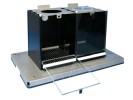Authors
Bentefour Y, Bennis M, Garcia R, m'hamed SB
Lab
Cadi Ayyad Université, Marrakech, Maroco
Journal
Psychopharmacology (Berl).
Abstract
RATIONALE:
After exposure to a severe traumatic event, avoidance, fear sensitization, and increased anxiety are among features that can persist over time in people developing posttraumatic stress disorder (PTSD). Basic research on treatment interfering with these symptoms can provide insights to improve PTSD treatment.
OBJECTIVES:
The purposes of the present study were to induce these behavioral changes in mice and examine whether paroxetine would interfere with their expression.
METHODS:
Mice were submitted to avoidance training with a low (0.4 mA) or high (1.5 mA) foot-shock intensity, as mild and severe stressors, respectively, and posttraining avoidance was evaluated 1 and 12 days later. Fear sensitization, measured as increased freezing to a neutral tone, and enhanced contextual fear, measured as increased freezing to a conditioned context (wherein all mice received a 0.4-mA foot-shock), were assessed during this time window. An elevated plus maze test was also used to assess mouse anxiety-like behavior.
RESULTS:
Persistent avoidance, persistent fear sensitization, and long-term enhancement of contextual fear and increased anxiety-like behavior were established only in mice that received the 1.5-mA foot-shock during avoidance training. Paroxetine (at 8 mg/kg/day), injected from day 5 to day 11 after avoidance training, suppressed all of these behavioral changes.
CONCLUSIONS:
These data provide additional evidence for the role of paroxetine against expression of PTSD-like behaviors in mice.
BIOSEB Instruments Used:
Shuttle Boxes (LE916)

 Douleur - Allodynie/Hyperalgésie Thermique
Douleur - Allodynie/Hyperalgésie Thermique Douleur - Spontanée - Déficit de Posture
Douleur - Spontanée - Déficit de Posture Douleur - Allodynie/Hyperalgésie Mécanique
Douleur - Allodynie/Hyperalgésie Mécanique Apprentissage/Mémoire - Attention - Addiction
Apprentissage/Mémoire - Attention - Addiction Physiologie & Recherche Respiratoire
Physiologie & Recherche Respiratoire
 Douleur
Douleur Métabolisme
Métabolisme Système moteur
Système moteur Neurodégénérescence
Neurodégénérescence Thématiques transversales
Thématiques transversales Système musculaire
Système musculaire Functions de motricité générale
Functions de motricité générale Troubles de l'humeur
Troubles de l'humeur Autres pathologies
Autres pathologies Articulations
Articulations Système Nerveux Central (SNC)
Système Nerveux Central (SNC)  Système sensoriel
Système sensoriel Bioseb on booth #14 at OARSI 2024 in Vienna
Bioseb on booth #14 at OARSI 2024 in Vienna 